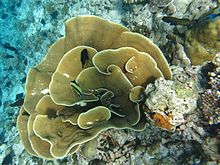Turbinaria mesenterina
| Turbinaria mesenterina | |
|---|---|

| |
| Scientific classification | |
| Domain: | Eukaryota |
| Kingdom: | Animalia |
| Phylum: | Cnidaria |
| Class: | Hexacorallia |
| Order: | Scleractinia |
| Family: | Dendrophylliidae |
| Genus: | Turbinaria |
| Species: | T. mesenterina
|
| Binomial name | |
| Turbinaria mesenterina | |
| Synonyms[2] | |
|
List
| |
Turbinaria mesenterina, commonly known as disc coral, is a species of colonial stony coral in the family Dendrophylliidae. It is native to the Indo-Pacific region. The International Union for Conservation of Nature has rated its conservation status as being "vulnerable".
Description
Turbinaria mesenterina is encrusting or forms flat or vase-shaped plates with corallites only on one side. The corallites are conical and about 2 mm (0.08 in) in diameter. This coral is quite variable in form, depending on depth and water conditions. It is very common in the Arabian area on sand and other sediments, and there it forms groups of vertical, interlocking plates which are usually greenish yellow, greenish grey or greyish brown. On upper reef slopes, colonies consist of upright or tiered plates, and in deeper water the plates are horizontal.[2]
Distribution and habitat
Turbinaria mesenterina is present in the Indo-Pacific region, its range extending from East Africa and the Red Sea to Taiwan, French Polynesia and eastern Australia. It is common in most reef environments and may be the dominant coral species in turbid habitats.[3]
Ecology
Turbinaria mesenterina is a
Status
Turbinaria mesenterina has a very wide distribution and is common throughout its range. It is collected for the aquarium trade, with Indonesia being the largest exporter. The reefs where it lives are being progressively damaged and rising sea water temperatures causes stress to corals. It is susceptible to coral diseases and bleaching, and although no particular population trend is apparent, the International Union for Conservation of Nature has assessed its conservation status as being "vulnerable".[1]
References
- ^ . Retrieved 20 November 2021.
- ^ a b c d Hoeksema, B. (2015). "Turbinaria mesenterina (Lamarck, 1816)". WoRMS. World Register of Marine Species. Retrieved 2015-04-19.
- ISBN 978-986-01-8744-1.
- .

